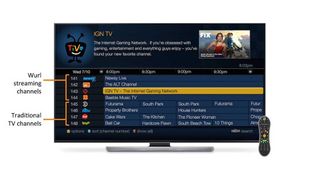OTT Becomes A-OK on the STB

After being held off at arm’s length, over-the-top video services are now being embraced enthusiastically by cable operators and integrated on their set-top box platforms at an accelerating rate.
The trend signals a major acknowledgment that it makes sense to weave OTT services into their own environments rather than ceding the entire audience to TV-connected retail streaming products, smart TVs, smartphones and tablets.
But it’s not the Wild, Wild West of retail OTT, as multichannel video programming distributors have also been taking a careful, curated approach to the number of services they stitch into their environments.
TiVo led the charge as it eventually integrated services such as Netflix on its MVPDleased boxes. Since then, the floodgates have seemingly opened as MSOs of all shapes and sizes have begun to follow suit.
Among them, Comcast has tied YouTube and Netflix to its X1 platform (with Sling TV and others on deck), and Charter Communications has similar OTT-facing plans for its new Worldbox platform. Layer3 TV, meanwhile, has stepped it up with services such as YouTube and Xumo, an ad-based OTT aggregator that is now complementing Layer3 TV’s traditional TV lineup with 100-plus digital channels from sources such as PeopleTV, FailArmy and Mashable.
The trend is also opening up opportunities for the likes of ZoneTV and Wurl, which specialize in platforms that tightly couple OTT services on MVPD set-top box platforms, and poured-in business for Metrological, which has played a big role in helping major operators such as Comcast and Liberty Global with their TV-OTT combinations.
Comcast’s Plunge A ‘Sea Change Moment’
Broadcasting & Cable Newsletter
The smarter way to stay on top of broadcasting and cable industry. Sign up below
Comcast’s move into OTT was a “sea change moment for the pay TV industry,” Sean Doherty, CEO of Wurl, said, noting that the thinking has evolved to: “If Comcast is doing it, it must be OK to embrace this streaming stuff.”
But, at a more general level, staying engaged with audiences has played a major role in these OTT strategies.
“If [the consumers] change the source, they aren’t coming back,” Greg Riker, senior vice president, Americas, for Metrological, said of the attitude that has taken hold among MVPDs. Integrating OTT has become “table stakes, driven by the consumer,” he added.
The minute a consumer pivots to a mobile device or a smart TV app for video could likewise turn into other lost opportunities, Lakshmana Pamarthy, head of marketing and business development at ActiveVideo (an Arris-Charter cloud video joint venture), said.
ActiveVideo, which uses its CloudTV StreamCast technology to bring OTT to IPand older non-IP boxes, has seen a “major activation” in MSO adoption of video streaming apps, he said. One example is Altice USA, which offers Hulu on its set-top boxes in the MSO’s Optimum (former Cablevision Systems) footprint.
MVPDs want to open up on OTT, but it has to come with “a business model that makes sense,” Jeff Weber, CEO of ZoneTV, said, acknowledging that the industry has “thrashed about a bit,” trying to solve that riddle.
“Everybody’s evolving to something that is more rational and driven by economics,” Weber said, adding that ZoneTV’s business is built on a dual-revenue model of subscriptions and advertising.
For its part, ZoneTV has built partnerships and a platform that can bring subscription VOD services as well as linear-style, AI-programmed “dynamic channels” to operator boxes and thematic or seasonal “pop-up” channels such as Santa Tracker, which features VOD movies, games and karaoke apps.
And the trend, Weber said, is being driven by a mix of competitive forces, including the emergence of virtual MVPDs.
“I see [the integration of OTT services] very clearly as a must-have. If they don’t do anything, they do find themselves in very deep trouble,” Weber said.
Cable Going All In On OTT
The latest OTT handiwork by cable ops isn’t about simply bolting on apps, but rather tighter couplings that baked streaming services into the guide and search engine along with the use of contextual metadata to help surface content.
“We believe that’s the direction that everything is going to go,” Riker said.
Tying OTT content to search and discovery on the set-top and making that fare reside in the box guide is critical. Without that, “It’s like sticking something in the far corner of K-Mart. No one’s going to find it,” Doherty said.
Integrating OTT at the set-top level is more the norm, but still not an easy thing to pull off from a technology level.
“It takes a lot of time and effort,” Riker said, pointing out that integrating a native app on the set-top involves the tying in of components such as video decoders, digital rights management systems and streaming players, and living up to the performance standard requirements of OTT providers and the MVPD.
But the good news is that the wheel doesn’t have to be constantly reinvented. “The first [integration] is always the longest and the hardest,” Riker said. “The demand for premium OTT by these operators … is really driving business for us.”
Though some MVPDs are leaning hard on new IP-capable set-tops to deliver OTT, ActiveVideo’s cloud-powered system also enables delivery on older boxes that aren’t equipped to do IP. That flexibility, Pamarthy said, can be a big CapEx saver because it means operators don’t have to deploy a new box to take advantage of OTT.
And that also requires a deeper integration as the platform needs to reconcile how content is secured for those various device types. “We see the merging of TV and OTT content as a work in progress,” he said.
Doherty also stresses that while OTT integrations open up MVPD platforms to a new, richer set of content, the benefits go further, as it’s more efficient than traditional TV channels that require operators to nail up bandwidth.
“It’s a far more flexible use of their plant,” he said of OTT-delivered channels.
